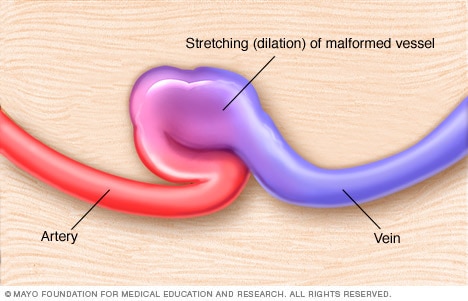AV Fistuloplasty (Dialysis Access Salvage)
An AV (arteriovenous) fistula is the best means of access to the bloodstream for long-term hemodialysis. It is created by connecting an artery to a vein, usually in your wrist or upper arm, and it helps to transfer blood into the dialysis machine and back again during hemodialysis.
Sometimes, even when you are very careful, your fistula may become infected, blocked, or narrowed. If an infection occurs, you will need a course of antibiotics. If there is any blockage or narrowing in your fistula, you may need to have a fistuloplasty.
A fistuloplasty is performed by an interventional radiologist (a doctor who uses x-rays to diagnose and treat illnesses). He/she will use dye (contrast agent that shows up on x-rays) to help locate the blockage or narrowing in your fistula. The blockage is then relieved by stretching the blood vessels with a special balloon.
An arteriovenous (AV) fistula is an abnormal connection between an artery and a vein. Normally, blood flows from your arteries to your capillaries to your veins. Nutrients and oxygen in your blood travel from your capillaries to tissues in your body.
With an arteriovenous fistula, blood flows directly from an artery into a vein, bypassing some capillaries. When this happens, tissues below the bypassed capillaries receive a diminished blood supply. Arteriovenous fistulas usually occur in the legs but can develop anywhere in the body. Arteriovenous fistulas are often surgically created for use in dialysis in people with severe kidney disease.
A large untreated arteriovenous fistula can lead to serious complications. Your doctor monitors your arteriovenous fistula if you have one for dialysis.
Symptoms
Small arteriovenous fistulas in your legs, arms, lungs, kidneys, or brain often won’t have any signs or symptoms and usually don’t need treatment other than monitoring by your doctor. Large arteriovenous fistulas may cause signs and symptoms.
Arteriovenous fistula signs and symptoms may include:
- Purplish, bulging veins that you can see through your skin, similar to varicose veins
- Swelling in the arms or legs
- Decreased blood pressure
- Fatigue
- Heart failure
An arteriovenous fistula in your lungs (pulmonary arteriovenous fistula) is a serious condition and can cause:
- A bluish tinge to the skin
- Clubbing of fingers
- Coughing up blood
An arteriovenous fistula in your gastrointestinal tract can cause bleeding in your digestive tract.
Causes
Causes of arteriovenous fistulas include:
Cardiac catheterization An arteriovenous fistula may develop as a complication of a procedure called cardiac catheterization. During cardiac catheterization, a long, thin tube called a catheter is inserted in an artery or vein in your groin, neck, or arm and threaded through your blood vessels to your heart.
If the needle used in the catheterization crosses an artery and vein during your procedure, and the artery is widened (dilated), this can create an arteriovenous fistula. This rarely happens.
Injuries that pierce the skin It’s also possible to develop an arteriovenous fistula after a piercing injury, such as a gunshot or stab wound. This may happen if your wound is on a part of your body where a vein and artery are sides by side.
Being born with an arteriovenous fistula Some people are born with an arteriovenous fistula (congenital). Although the exact reason why isn’t clear, in congenital arteriovenous fistulas the arteries and veins don’t develop properly in the womb.
Genetic conditions Arteriovenous fistulas in the lungs (pulmonary arteriovenous fistulas) can be caused by a genetic disease (Osler-Weber-Rendu disease, also known as hereditary hemorrhagic telangiectasia) that causes blood vessels to develop abnormally throughout your body, but especially in the lungs.
Surgical creation (AV fistula procedure) People who have late-stage kidney failure may have an arteriovenous fistula surgically created to make it easier to perform dialysis. If a dialysis needle is inserted into a vein too many times, the vein may scar and be destroyed.
Creating an arteriovenous fistula widens the vein by connecting it to a nearby artery, making it easier to insert a needle for dialysis and causing blood to flow faster. This AV fistula is usually created in the forearm.

